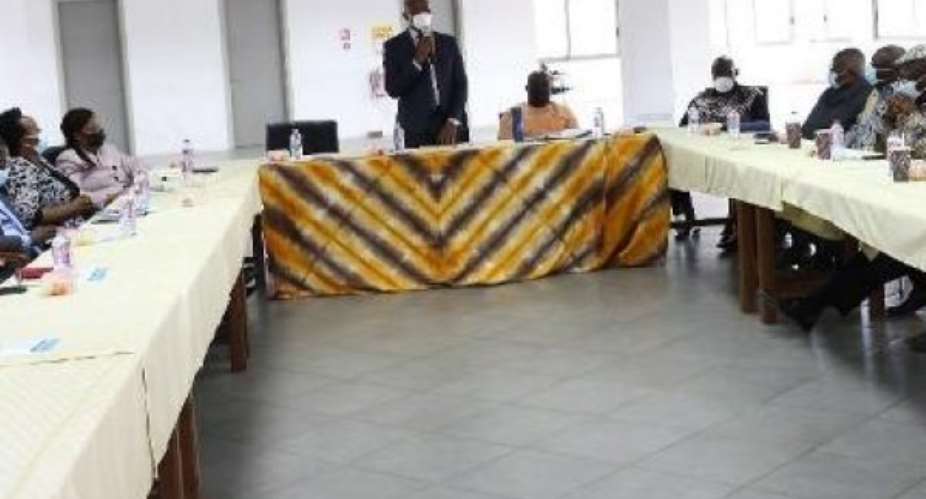Mr Michael Luguje, Director General of the Ghana Ports and Harbours Authority (GPHA) has said the Keta Port, when constructed would be economically viable, due to the commercial dynamics in the maritime trade.
He said trade was not conservative therefore trade was always looking for access, facilitation, competitiveness, and convenience.
He was speaking at a stakeholder meeting with the Ben Kwao Group, an association of indigenes and ambassadors of the Keta township, who visited the Port Authority to acquaint themselves with the Keta Port project.
He said just like in a market one would find many stalls selling the same products but all of them were successful in their business despite being next to each other.
He explained that a shipping line investing its own resources in a port, like Lomé would be still interested in investing in other neighbouring ports as they might have worked out the economics and realized that concentrating in just one port would not be the best economically as each county has its special advantage.
“Ghana's economy is much bigger than Togo, so if a shipping line is present in Lomé, they probably be looking at cargoes not only coming to Lomé, but to other regions.
“But for Ghana, you would have the opportunity of having way more cargoes bound for Ghana in addition to ones bound for other countries, from the economic point of view, there are a lot of positives that prove Keta is viable,” he added.
Explaining the genesis of the proposed Keta Port, he said “Diamond Cement wanted to get a jetty in Keta with deeper berth to accommodate bigger vessels than what they use in Lomé and even cart the clinker by road to the factory, it would be more profitable; That is why despite their investment in rail, they were prepared to come and invest in Keta.”
Mr Luguje however said, GPHA could not have given Diamond Cement the right to operate and own a private port as it was against the laws of Ghana, hence that deal was not able to go through as initially envisaged by the company.
“They thought with the level in investment they were going to make, they had to own the port as a private facility.
“We told them that they can invest in the port, and based on the size of their investment, we could give a longer concession term that would give them all the protection they need, that delayed the MOU we signed with them,” he said.
He noted that during the feasibility studies however, they were engaged extensively to let them know, government would invest in the fundamental port works, and the Keta Port master plan could accommodate a Diamond Cement Terminal, so it is not dead.
Dr Alexendar Yaw Adusei, Director in Charge of the Keta Port Project asked interested parties in the project to be patient to allow the GPHA go through the needed processes saying it takes such calculated processes to make such a mega project successful.
He said “The major part of a port project is planning, at this point we are willing to listen to all suggestions that can help make the project a success for the people of Keta as well as the Volta and Oti regions, so we need to unite as a family to get this project done;
“This is the closest we have come to realizing this project”.
Mr Komla Ofori, Project Engineer on his part revealed that the general feasibility outlay was done with environmental and social impact assessment pending.
Mr John Klinogo, Vice Chairman of the Ben Kwao Group described the engagement as an eye-opener in understanding the processes that lead to the completion of a port.
“We now know that when you are doing a project of this size, you need time to do your feasibility studies. Naïve as some of us are, as soon as we heard Keta Port, and that a director has been appointed, then surely there must be some excavation and dredging works ongoing. But it is not so.”
GNA





 Ghana will make maiden voyage into space should Bawumia become President — Chair...
Ghana will make maiden voyage into space should Bawumia become President — Chair...
 Train crash: Despite the sabotage, we shall not be deterred and will persevere —...
Train crash: Despite the sabotage, we shall not be deterred and will persevere —...
 Tema-Mpakadan railway project a perversion of the original viable concept design...
Tema-Mpakadan railway project a perversion of the original viable concept design...
 Train crash: Elsewhere, everyone involved in the test will either be fired or re...
Train crash: Elsewhere, everyone involved in the test will either be fired or re...
 Ghana, other election bound-countries must build fiscal buffers – IMF admonishes
Ghana, other election bound-countries must build fiscal buffers – IMF admonishes
 Parliament reconvenes late May, denies Speaker Bagbin delaying recall over NDC t...
Parliament reconvenes late May, denies Speaker Bagbin delaying recall over NDC t...
 $100m needed to revitalise Ghana's poultry sector — GNAPF
$100m needed to revitalise Ghana's poultry sector — GNAPF
 Driver arrested for causing train collision on Tema-Mpakadan Railway Line
Driver arrested for causing train collision on Tema-Mpakadan Railway Line
 Police grab trucker for Tema-Mpakadan rail accident
Police grab trucker for Tema-Mpakadan rail accident
 Gov't plans to revise traditional customs following Gborbu child marriage
Gov't plans to revise traditional customs following Gborbu child marriage
